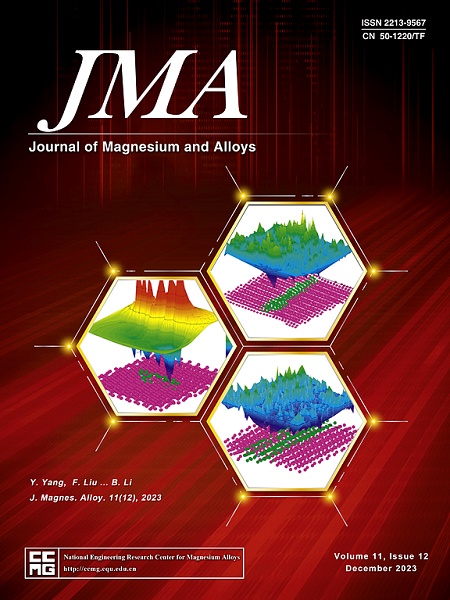Calcination temperature-dependent structural, optical, and photoluminescence properties of Mg-Al bimetallic oxide prepared by sol-gel auto combustion method
IF 15.8
1区 材料科学
Q1 METALLURGY & METALLURGICAL ENGINEERING
引用次数: 0
Abstract
In this research study, magnesium-aluminum (Mg-Al) bimetallic oxide powders are synthesized via the sol-gel auto combustion method using diethanolamine (DEA) as the fuel. In order to subsequently determine the influence of calcination temperatures upon the structure, chemical bonding, morphology, optical properties, and fluorescence properties of the as-synthesized and calcined Mg-Al bimetallic oxide powders, the researcher employed X-ray diffraction (XRD), Fourier transform infrared spectroscopy (FT-IR), scanning electron microscopy (SEM), transmission electron microscopy (TEM), UV–visible diffuse reflectance spectroscopy (UV-DRS), and photoluminescence spectroscopy (PL), respectively. It was apparent on the basis of the XRD and FT-IR analyses that those powders undergoing calcination at temperatures of 500 °C, 700 °C, and 900 °C contained the major phase magnesium aluminate (MgAl2O4) spinel with trace magnesium oxide (MgO) and hydrotalcite (Mg6Al2(CO3)(OH)16). When the calcination temperature rose to 1100 °C, this resulted in a single phase MgAl2O4 while MgO and (Mg6Al2(CO3)(OH)16) were no longer observed. UV-DRS analysis revealed that in optimized conditions, calcination resulted in better sample absorption and reflection levels when compared to the ultraviolet, visible, and infrared spectra observed in the case of the as-synthesized sample. The bandgap energy (Eg) for calcined samples was in the range of 2.65 eV to 5.85 eV, in contrast to the value of 4.10 eV for the as-synthesized sample. Analysis of photoluminescence showed that for the as-synthesized samples and those calcined at low temperatures, visible light was emitted only in the violet, blue, and green regions with low intensity, while for samples calcined at higher temperatures, the emissions showed greater intensity and extended to the yellow and orange regions. Multiple defect centers were found in the bandgap which can explain these findings.

溶胶-凝胶自燃烧法制备Mg-Al双金属氧化物的结构、光学和光致发光性能
本研究以二乙醇胺(DEA)为燃料,采用溶胶-凝胶自燃烧法合成镁铝双金属氧化物粉末。为了随后确定煅烧温度对合成和煅烧的Mg-Al双金属氧化物粉末的结构、化学键、形貌、光学性能和荧光性能的影响,研究人员采用了x射线衍射(XRD)、傅里叶变换红外光谱(FT-IR)、扫描电子显微镜(SEM)、透射电子显微镜(TEM)、uv -可见漫反射光谱(UV-DRS)、和光致发光光谱(PL)。XRD和FT-IR分析表明,经过500℃、700℃和900℃煅烧的粉末中含有铝酸镁(MgAl2O4)尖晶石、微量氧化镁(MgO)和水滑石(Mg6Al2(CO3)(OH)16)。当煅烧温度上升到1100℃时,得到单相MgAl2O4, MgO和(Mg6Al2(CO3)(OH)16)不复存在。UV-DRS分析显示,与合成样品的紫外、可见光和红外光谱相比,在优化条件下,煅烧产生了更好的样品吸收和反射水平。煅烧样品的带隙能(Eg)在2.65 ~ 5.85 eV之间,而合成样品的带隙能为4.10 eV。光致发光分析表明,对于合成样品和低温煅烧样品,可见光仅在低强度的紫色、蓝色和绿色区域发射,而对于高温煅烧样品,发射强度更大,并扩展到黄色和橙色区域。在带隙中发现了多个缺陷中心,这可以解释这些发现。
本文章由计算机程序翻译,如有差异,请以英文原文为准。
求助全文
约1分钟内获得全文
求助全文
来源期刊

Journal of Magnesium and Alloys
Engineering-Mechanics of Materials
CiteScore
20.20
自引率
14.80%
发文量
52
审稿时长
59 days
期刊介绍:
The Journal of Magnesium and Alloys serves as a global platform for both theoretical and experimental studies in magnesium science and engineering. It welcomes submissions investigating various scientific and engineering factors impacting the metallurgy, processing, microstructure, properties, and applications of magnesium and alloys. The journal covers all aspects of magnesium and alloy research, including raw materials, alloy casting, extrusion and deformation, corrosion and surface treatment, joining and machining, simulation and modeling, microstructure evolution and mechanical properties, new alloy development, magnesium-based composites, bio-materials and energy materials, applications, and recycling.
 求助内容:
求助内容: 应助结果提醒方式:
应助结果提醒方式:


